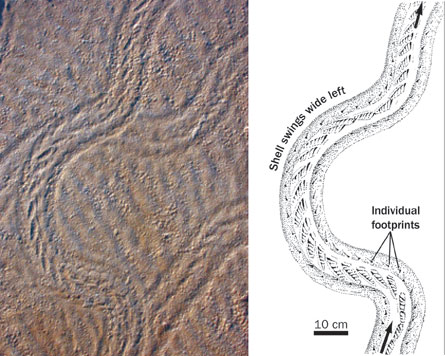Have shell, will travel
Fossilized tracks left by early land-dwelling animals reveal they brought shells ashore
Share this:
- Share via email (Opens in new window) Email
- Click to share on Facebook (Opens in new window) Facebook
- Click to share on X (Opens in new window) X
- Click to share on Pinterest (Opens in new window) Pinterest
- Click to share on Reddit (Opens in new window) Reddit
- Share to Google Classroom (Opens in new window) Google Classroom
- Click to print (Opens in new window) Print
 |
|
A creature much like a modern hermit crab likely made these tracks 500 million years ago. |
| W. Hagadorn |
Many modern animals, like crabs, live in shells and carry their homes around with them. Picture one of these animals in your mind, and you may have some idea of what the first land-dwelling animals looked like. After studying strange marks that accompany some sets of ancient fossil footprints, scientists recently suggested that the oldest creatures to crawl out of the ocean probably wore shells.
Scientists have long known that life on Earth began in the sea. The first vertebrates — animals with backbones — came crawling out of the water between 385 million and 376 million years ago. But those animals weren’t the first creatures to come ashore, says paleontologist James W. Hagadorn of Amherst College in Massachussetts.
Hagadorn and Yale University paleontologist Adolf Seilacher say that a different group of animals, called arthropods, probably beat the first land vertebrates by more than 100 million years. Arthropods are animals that lack a backbone and have a hard exoskeleton. Examples include modern-day scorpions and insects. These ancient arthropods may have dragged themselves out of the ocean 500 million years ago.
These ancient arthropods had the right kind of bodies to survive out of the water, says Hagadorn. Their hard exoskeletons would have kept them from drying out too quickly. And though these creatures breathed through gills, which require water, a shell would have trapped humid air. This handy gear would allow the animals to keep their gills moist.
The paleontologists found evidence for the shells by studying fossilized, or preserved, tracks discovered in central Wisconsin. The tracks were left by the ancient arthropods as they walked around on soft ground. Over time, this soft ground hardened, and the tracks remained as etchings in stone.
When the scientists looked at the fossilized tracks, they found something strange. Some of the tracks included an extra mark alongside the footprints. Whenever the tracks turned, to the right or to the left, the extra mark swung out a little wider, always to the left. The scientists realized this mark could not have been made by a tail, because a tail would swing out wider on both sides. If the animal turned left, a tail
would have swung right; if the animal turned right, a tail would have swung left.
Because the mark swung out on one side only, the scientists believe it was made by a shell that dragged on the ground. Furthermore, they suspect the shell was coiled, probably in a right-hand spiral.
“This is an exciting find,” says Sally E. Walker, a paleobiologist at the University of Georgia in Athens. Now, she says, scientists can approach these ancient arthropods from a different direction. They can study ancient shells to look for scratch marks on the outside that might have been made as the shells were dragged through the sand. Or, she says, researchers can look for scratch marks on the inside — which may suggest that another animal took over a shell, after the original animal that lived there died.
Power words: (from the Yahoo! Online Kids dictionary)
Paleontology: The study of the forms of life existing in prehistoric or geologic times, as represented by the fossils of plants, animals and other organisms.
Fossil: A remnant or trace of an organism of a past geologic age, such as a skeleton or leaf imprint, embedded and preserved in Earth’s crust.
Arthropod: Any of numerous invertebrate animals of the phylum
Arthropoda, including the insects, crustaceans, arachnids and myriapods, that are characterized by an exoskeleton made of a hard material called chitin and a segmented body to which jointed appendages are attached in pairs.
Gills: The respiratory organ of most aquatic animals that breathe water to obtain oxygen.
Going Deeper:







